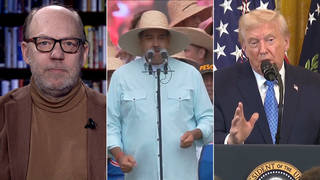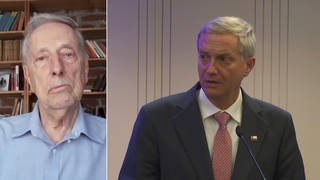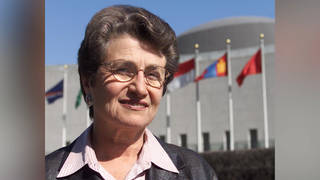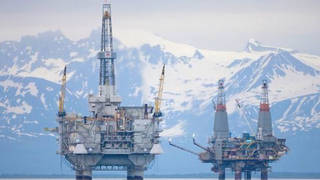
Guests
- Subhankar Banerjeerenowned photographer, writer and activist who has spent the past 15 years working for the conservation of the Arctic and raising awareness about indigenous human rights and climate change. He is editor of the anthology, Arctic Voices: Resistance at the Tipping Point. Banerjee’s recent piece for TomDispatch is called “To Drill or Not to Drill, That is the Question.” In 2012, he won a Cultural Freedom Award from the Lannan Foundation.
The Obama administration has tentatively approved Shell’s plans to begin oil extraction off the Alaskan coast this summer. Federal scientists estimate the Arctic region contains up to 15 billion barrels of oil, and Shell has long fought to drill in the icy waters of the Chukchi Sea. Environmentalists warn Arctic drilling will pose a risk to local wildlife and exacerbate climate change. They fear that a drilling accident in the icy Arctic Ocean waters could prove far more devastating than the deadly 2010 Gulf of Mexico spill since any rescue operations could be delayed for months by harsh weather conditions. We speak to Subhankar Banerjee. He is a renowned photographer, writer and activist who has spent the past 15 years working for the conservation of the Arctic and raising awareness about indigenous human rights and climate change. He is editor of the anthology, “Arctic Voices: Resistance at the Tipping Point.”
Transcript
NERMEEN SHAIKH: The Obama administration has tentatively approved Shell’s plans to begin oil extraction off the Alaskan coast this summer. Federal scientists estimate the Arctic region contains up to 15 billion barrels of oil, and Shell has long fought to drill in the icy waters of the Chukchi Sea.
AMY GOODMAN: Environmentalists warn Arctic drilling will pose a risk to local wildlife and exacerbate climate change. They fear a drilling accident in the icy Arctic Ocean waters could prove far more devastating than the deadly 2010 Gulf of Mexico spill, since any rescue operations could be delayed for months by harsh weather conditions. Speaking to KTUU, Lois Epstein of The Wilderness Society denounced the government’s decision to greenlight oil exploration.
LOIS EPSTEIN: Their record from 2012 drilling in the Arctic Ocean was a disaster, by anyone’s measure. One of their of drill rigs grounded near Kodiak. There were fires. There were criminal penalties for air pollution violations.
AMY GOODMAN: For more, we go to Washington, D.C.—Washington state, where we’re joined by Subhankar Banerjee. He’s a renowned photographer, writer and activist who’s spent the past 15 years working for the conservation of the Arctic and raising awareness about indigenous human rights and climate change, editor of the anthology, Arctic Voices: Resistance at the Tipping Point. His recent piece for TomDispatch is called “To Drill or Not to Drill, That is the Question.” In 2012, he won a Cultural Freedom Award from the Lannan Foundation.
Subhankar Banerjee, welcome back to Democracy Now! Can you talk about the Obama administration decision and what this means for the Arctic?
SUBHANKAR BANERJEE: The decision is both irresponsible and reckless. But let me clarify something at the beginning. What the administration has approved now is the exploration plans for Shell to drill this summer, starting from July to October. But this is not the—this is the most significant permit that Shell needs, but not all of the permits. So Shell still needs more permits from, like, NOAA, Fish and Wildlife Service and other federal agencies. So that’s why the activists are working very hard to make sure that some are—some of these permits are not granted, because it’s a reckless decision, as you mentioned, for multiple reasons, the primary ones being a spill in the Arctic Ocean would be far more devastating than what happened in the Gulf of Mexico. And the administration has finally acknowledged, after losing in two federal courts—one in 2010 and one in 2014—that there is a 75 percent chance of one or more major spills if exploration leads to production. So a spill is inevitable.
And if a spill does happen, as you mentioned, that, let’s say, a spill happens late in the season, like in October, then that oil will have to be left in place for like nine months, because the sea ice gets covered, covers the Arctic Sea, until the ice melts the following year, when effective cleanup can begin. But even if the spill happens in the summertime, it is a real problem, because the Arctic Sea always has constant dangers of large ice flows—and Shell already encountered that in their 2012 drilling season—as well as deep fog that severely restricts visibility, and the storms have become more violent and more intense. You combine that with the fact that there is absolutely no deep water port in U.S. Arctic—the nearest Coast Guard station is a thousand miles away—and there is no infrastructure in place. Like in your previous segment, you were talking about infrastructure. There is absolutely no infrastructure in place to respond to a large spill. So that’s the spill site.
The second site that we need to understand, that Arctic is what is called the integrator of world’s climate systems, both atmospheric and oceanic. Just to give you a couple of examples, what happens in the Arctic affects not just the Arctic, but the whole planet. The severe—recent years, severe winter weather in the Northeast of U.S. as well as the severe ongoing drought in California both have now been linked by recent scientific studies to slowing down of the Arctic jet stream, because the Arctic is warming at a much faster rate than the lower latitudes. And the second one is the Gulf Stream, where you have the warm water from the Gulf of Mexico and the southern latitudes go up to the Arctic, goes down into the deep ocean, gets cold and comes back. It’s called the Gulf Stream, that maintains, again, our oceanic and atmospheric process. That, too, is slowing down. And its impacts are not yet very well understood, but one thing is that it will further contribute to the increase of the sea level. So what happens in the Arctic affects us all, but also to the indigenous people up there. And you mentioned the ecology of the region. If the American public knew what is in those Arctic seas of America—Beaufort and the Chukchi—they will not allow drilling there, because it is truly a national and an international ecological treasure.
NERMEEN SHAIKH: Well, according to this ad by Shell, the oil company has developed unprecedented Arctic oil spill response contingency plans.
SHELL AD: Shell’s Alaska exploration program is defined by its remoteness, and Shell has gone to great lengths to make sure a worst-case scenario, such as an oil spill, never takes place. But in the unlikely event that one did, Shell’s on-site oil spill response assets would be deployed and recovering oil within one hour. The recovery effort would be aided by nearshore response equipment and onshore oil spill response equipment. This kind of 24/7 response capability is unprecedented.
NERMEEN SHAIKH: Subhankar, could you comment on what the Shell ad says and also tell us a little about Shell’s record in the Arctic region?
SUBHANKAR BANERJEE: What you just mentioned, Nermeen, is nothing new. It is sugarcoating on an old rhetoric that Shell has been peddling for the last few years. In 2010, Shell spent millions of dollars on an ad campaign called “Let’s Go” to pressure the Obama administration to grant them the various permits, and then towards the—and also another ad called “We have the technology—Let’s go.” So Shell has been saying this for the last at least five years now. Nothing has changed. All of the things I just mentioned previously has not changed. The government acknowledges it, that there would be a major spill. And if it does a spill happen, this whole idea of “We have the technology” is nothing but a PR campaign with no truth behind it, as industry and government would acknowledge, that if a spill does happen in the icy waters, the cleanup would be very ineffective compared to the Gulf of Mexico.
And then I forgot the second part of the question—oh, Shell’s record in the Arctic. So Shell went up there with, again, a conditional permit from the Obama administration in 2012, conditional because they were not allowed to drill all the way to the oil-bearing zone, only a top hole drilling to prepare for the following season. And what ended up happening? The very first day they started drilling, they encountered an ice flow the size of Manhattan, 30 miles by 10 miles long, and had to immediately halt operation and disconnect from the sea floor anchor. When they were coming—while they were going up to the Arctic, their drill ship, Noble Discoverer, almost ran aground off of the Dutch Harbor in Southwest Alaska. And then, while coming back, the Noble Discoverer caught fire, and the engine suffered damage, while the other drill ship, Kulluk, was grounded in the Gulf of Alaska, near Sitkalidak Island. And the reason they were bringing the Kulluk back was—actually, to the Seattle waters, Puget Sound water—is because Shell tried to avoid Alaska taxes. So it all goes back to the fact that right now the price of oil is low. And it is truly incredibly irresponsible, when price is—price of oil is low, and the technologies don’t exist, the infrastructure don’t exist, to send Shell up there, because Shell will try to cut costs, as they did in 2012. And the company and its subcontractor, Noble Drilling, was fined a total of $12 million, Noble Drilling, and $2 million to Shell, for violating numerous environment laws, including the Clean Air Act, as well as the Clean Water Act.












Media Options